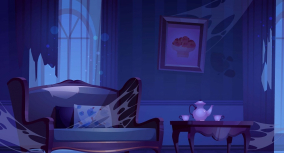This article by Custom-Writing.org experts contains a comprehensive analysis of literary devices in The Yellow Wallpaper: color symbolism, personification, point of view used by Gilman, foreshadowing, and an explanation of the ending’s meaning.

🌈 The Yellow Wallpaper: Symbolism
How unfortunate is it that a woman has a mental breakdown just because of the yellow wallpaper? Of course, it is not only the wallpaper. You may find this out from The Yellow Wallpaper’s analysis below.
Something is hiding behind all the colors and shapes of the mansion’s top room. As you read the story more closely, you figure out that the color, the room, and the wallpaper itself serve as symbols.
If you are wondering why the wallpaper is yellow in the story, we invite you to study this section.
Color Symbolism of the Yellow Wallpaper
The pattern and the yellow color carry many details about the narrator. Let’s find out about the significance of these details.
The color yellow would be linked with illness and weakness. Indeed, we see the narrator suffering from an unknown mental disorder. Moreover, as she describes in her journal, the color becomes more and more disgusting for her every day.
To illustrate it, we can use some of the quotes from The Yellow Wallpaper. The woman writes:
The color is hideous enough and unreliable enough, and infuriating enough…
The Yellow Wallpaper, entry 5
The only thing I can think of that it is like is the color of the paper! A yellow smell.
The Yellow Wallpaper, entry 7
However, there is more to that. Another interpretation goes back to the theme of feminism and gender roles. The theme is the main focus of the story. It may have been used to represent the oppression of men towards women.
All the adjectives Gilman uses there to describe the color, such as “hideous” and “infuriating,” perfectly align with her feelings about inequality.
Another thought that is worth attention is quite similar. Sometimes, yellow is used in relation to some evil acts. Thus, the way how John treats his wife might find the representation in the color of the wallpaper. She finds imprisonment and patronizing as the acts of male dominance.
Moreover, it seems like people facing some severe obsessions tend to project their feelings like anxiety onto simple objects. Therefore, it would explain why the narrator is so crazy over the wallpaper, and the color is yellow.
There are more interpretations of the color yellow out there, though. According to one of them, yellow represents decay and caution. It may fit into the story since we watch the narrator’s life and marriage fall apart, as well as her mental health.
All in all, after the color symbolism of The Yellow Wallpaper is explained, you might understand that the setting plays a far more critical role than it seems.
Why Is the Wallpaper Yellow in The Yellow Wallpaper?
There is no need to wonder what the color yellow symbolizes in The Yellow Wallpaper. There are several different interpretations, and you would need to read the full article to figure it out. However, yellow is often associated with decay, sickness, and weakness. Of course, it refers to the narrator’s mental health and life in general.
The wallpaper in the room, which most likely used to be a nursery, is yellow, and it is not a coincidence. Gilman might have known about the true meaning of this color and chose it on purpose. It relates to illness and decay. Therefore, the yellow wallpaper is a symbol of the narrator’s mental deterioration.
What Does the Room Symbolize in The Yellow Wallpaper?
To find out what the room symbolizes in The Yellow Wallpaper, we need to focus on the narrator’s mental health again. Such a poor state of the place where everything happens represents decay. All the holes in the floor, tears in paper, and the smell point out at the woman’s mind’s poor state.
What Does the Woman in the Yellow Wallpaper Symbolize?
At the beginning of the story, it is reasonable to wonder about The Yellow Wallpaper’s symbolism. However, by the end, it becomes clear the mysterious figure of a lady from behind the wallpaper is the personification of the narrator’s despair and loneliness. It appears to point out how insecure and oppressed she feels.
📚 The Yellow Wallpaper: Literary Analysis
The various literary devices Gilman uses in The Yellow Wallpaper highlight horror. Some of them align with the story’s themes. They help the reader to piece the puzzle together as the story progresses. Dialogues, symbols (to be discussed in the next section), point of view – everything makes sense.
Literary Devices in The Yellow Wallpaper
What literary devices are used in The Yellow Wallpaper? The topic is worth attention.
Gilman uses different devices to set the mood and describe the setting and the feelings of the narrator:
- Repetition helps the reader understand how confused the woman is when she keeps wondering what to do.
- Next, the narrator describes the wallpaper using the different definitions in the same sentence.
- Apart from the other standard literary devices, such as metaphor and personification, Gilman enjoys squeezing as much irony into the dialogue as she can.
Personification in The Yellow Wallpaper
Gilman uses personification in The Yellow Wallpaper to convey the narrator’s sense of imprisonment and isolation. The wallpaper itself is given human-like qualities, such as patterns “committing sins,” “plunging,” and “destroying themselves.” The personification of the wallpaper serves as a metaphor for the narrator’s entrapment and descent into madness. It also creates a sense of unease and tension.
The Yellow Wallpaper Literary Devices: Irony
The irony is a key element of the story’s unique unsettling tone. It highlights the disconnection between appearance and reality, as well as the flaws in the dominant societal beliefs of that period. There are several instances where it creates a particularly powerful effect:
- The narrator’s husband, John, is a physician who is supposed to help her get better, but his treatment ultimately drives her deeper into madness. He believes that rest and seclusion are the best medicine for her. Ironically, they only exacerbate her condition.
- Another instance is the narrator’s obsession with the wallpaper—a symbol of her confinement—ultimately leading her to liberation.
- The idea that the narrator is a writer who is forbidden from writing adds another layer of irony to the story.
The Yellow Wallpaper: Point of View
Point of view is the central aspect of the whole story. Since The Yellow Wallpaper is written as a journal, the story is told in the first person. The narrator focuses on her thoughts, feelings, and insights. Therefore, we have a chance to see everything from her point of view.
On the other hand, all the events are filtered through her perception, so we cannot judge them objectively. As the story develops, the narrator’s mental health becomes less and less stable. It is hard to tell whether her story aligns with the reality and perception of the other characters.
She also confesses that she cannot share everything with the diary. The reader might even miss some real events.
Foreshadowing in The Yellow Wallpaper
The imagery Gilman creates by using foreshadowing in The Yellow Wallpaper sets up the whole story’s mood. The reader can feel that something horrible is about to happen but only has scattered clues at the beginning.
Some of them appear to be quite suspicious, like the teeth marks, which the narrator finds on the bedstead. She is unable to tell who left them. Later we can identify them as a sign of her going insane. Moreover, they might also mean that she is not telling the full story.
Another use of foreshadowing can be found when the narrator writes about “creepy” things. This is related to the further use of the word “creeping” and signifies her desperation.
🔚 What Does The Ending Mean?
Along with the main idea of The Yellow Wallpaper, readers are often confused with the ending.
Even though the narrator writes about her liberation, many questions remain. Not only is her true identity wiped out by the woman from the wallpaper. She keeps walking along the mark on the wall.
The story cuts off there, and the reader might suppose that the woman wound up trapped in another cage. This time, her “wallpaper” identity refuses to leave the room.
One can also interpret the ending from a feminist perspective. In the narrator’s desperate attempts to free herself from her patronizing husband, she gets trapped in her mind.
Why Does John Faint at the End of The Yellow Wallpaper?
Some critics are convinced that John’s unconsciousness points out his weakness. Throughout the story, he has been posing as an example of a “real man.” In the end, though, the truth about his more feminine side is revealed. He faints, just like a woman. This creates a kind of balance since the narrator then becomes independent.
We hope that the above analysis of The Yellow Wallpaper is useful. If you want to be fully aware of the true meaning of the story, you should check out both The Yellow Wallpaper summary and character sections. And if you’re looking for exciting essay ideas on the story, please read this article.






